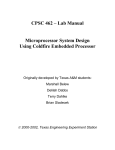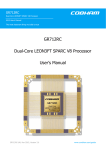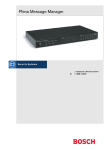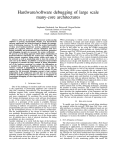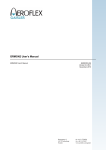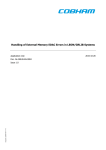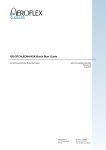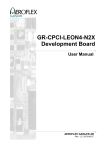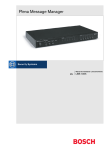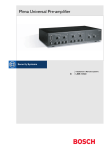Download Quick Start Guide for GR712 Development Board
Transcript
. Quick Start Guide for GR712RC-BOARD 1 Quick Start Guide for GR712 Development Board GR712-BOARD Quick Start Guide QSG-GR712 Version 0.1.0 November 2013 Kungsgatan 12 411 19 Gothenburg Sweden tel +46 31 7758650 fax +46 31 421407 www.aeroflex.com/gaisler Quick Start Guide for GR712RC-BOARD 2 Quick Start Guide for GR712RC-BOARD Copyright © 2013 Aeroflex Gaisler AB Quick Start Guide for GR712RC-BOARD iii Table of Contents 1. Introduction ...................................................................................................................... 1 1.1. Overview ............................................................................................................... 1 1.2. References ............................................................................................................. 1 2. Board Configuration .......................................................................................................... 2 2.1. Overview ............................................................................................................... 2 2.2. Clock Sources ........................................................................................................ 2 2.3. I/O Switch Matrix .................................................................................................. 3 2.4. UART ................................................................................................................... 4 2.5. PROM .................................................................................................................. 4 3. GRMON hardware debugger ............................................................................................... 5 3.1. Overview ............................................................................................................... 5 3.2. Debug-link alternatives ............................................................................................ 5 3.2.1. Connecting via the FTDI USB/JTAG interface ................................................... 5 3.2.2. Connecting via SpaceWire RMAP interface ...................................................... 5 3.3. First steps .............................................................................................................. 5 3.4. Connecting to the board ........................................................................................... 6 4. Software ........................................................................................................................ 13 4.1. Overview ............................................................................................................. 13 4.2. Bare C Cross-Compiler System ............................................................................... 13 4.2.1. Overview .................................................................................................. 13 4.2.2. Installing BCC ........................................................................................... 13 4.2.3. Compiling with BCC ................................................................................... 14 4.2.4. Running and debugging with GRMON ........................................................... 14 4.3. RTEMS Real Time Operating System ....................................................................... 15 4.3.1. Overview .................................................................................................. 15 4.3.2. Installing RCC ........................................................................................... 15 4.3.3. Building an RTEMS sample application .......................................................... 15 4.3.4. Running and debugging with GRMON ........................................................... 16 4.4. MKPROM2 .......................................................................................................... 17 4.4.1. Overview .................................................................................................. 17 4.4.2. Usage of MKPROM2 .................................................................................. 17 4.5. VxWorks ............................................................................................................. 18 4.5.1. Overview .................................................................................................. 18 5. Frequently Asked Questions / Common Mistakes / Know Issues ............................................... 19 5.1. Clock gating ......................................................................................................... 19 5.2. GRMON issues ..................................................................................................... 19 5.3. Clock problems ..................................................................................................... 19 5.4. Switch Matrix Configuration Problems ...................................................................... 19 5.5. GPIO .................................................................................................................. 19 5.6. SDRAM configuration ........................................................................................... 19 5.7. Multiprocessor & legacy support .............................................................................. 20 5.8. Interrupts ............................................................................................................. 20 5.9. GRMON Debug Link Limitations ............................................................................ 20 5.10. MIL-1553 .......................................................................................................... 20 6. Support .......................................................................................................................... 21 Quick Start Guide for GR712RC-BOARD 1 1. Introduction 1.1. Overview This document is a quick start guide for the GR712RC Development Board. The purpose of this document is to get users quickly started using the board. For a complete description of the board please refer to the GR712RC Development Board User Manual, the GR712RC system-on-chip is described in the GR712RC User Manual. This quick start guide does not contain as many technical details and is instead how-to oriented. However, to make the most of the guide the user should have glanced through the aforementioned documents and should ideally also be familiar with the GRMON debug monitor. 1.2. References Table 1.1. References RD-1 GR712RC Development Board User Manual RD-2 GR712RC User Manual [http://gaisler.com/doc/gr712rc-usermanual.pdf] RD-3 GR712RC Data Sheet [http://www.gaisler.com/doc/gr712rc-datasheet.pdf] RD-4 GRMON User's Manual [http://www.gaisler.com/doc/grmon2.pdf] RD-5 RTEMS homepage [http://www.rtems.org] RD-6 RTEMS Cross Compilation System (RCC) [http://www.gaisler.com/index.php/products/operating-systems/rtems] RD-7 RCC User's manual [http://gaisler.com/anonftp/rcc/doc] RD-8 Aeroflex Gaisler RTEMS driver documentation [http://gaisler.com/anonftp/rcc/doc] RD-9 GRTOOLS homepage [http://www.gaisler.com/index.php/downloads/grtools] RD-10 Bare C Cross-Compilation System [http://www.gaisler.com/index.php/products/operating-systems/bcc] RD-11 BCC User Manual [http://www.gaisler.com/doc/bcc.pdf] RD-12 MKPROM2 User Manual [http://gaisler.com/doc/mkprom.pdf] The referenced documents can be downloaded from http://www.gaisler.com. Quick Start Guide for GR712RC-BOARD 2 2. Board Configuration 2.1. Overview The primary source of information for board configuration is the GR712RC Development Board User Manual. The board requires some hardware configuration to fit with the customer requirements. In particular, the number of the GR712RC-BOARD's processor I/O pins limits the simultaneously available connections to external interfaces. To overcome this limitation, the SoC features an internal switch matrix, and a set of jumpers must be configured accordingly to route the signals to the appropriate headers on the board. The internal switch matrix is configured by enabling the respective interfaces via software. Additionally, clock selection might need to be configured by a set of jumpers and possibly the insertion of custom oscillators. Figure 2.1. GR712RC-BOARD default configuration as delivired 2.2. Clock Sources The minimum requirement in order for the board to work and to be able to connect to it, is that the clock sources are properly configured. The 80 MHz oscillator in socket X2 provided by default with the board is Quick Start Guide for GR712RC-BOARD 3 connected to the system clock input through the JP84 jumper in the default configuration 2-3. The on-board soldered 48 MHz oscillator can be used instead by positioning the JP84 jumper on pins 1-2. Alternatively a custom oscillator can be installed in X2. The SpaceWire clock is, by default, driven by an on board additional 100 MHz oscillator. If the user wants to use the system clock configured in the paragraph above as the source of the SpaceWire clock, then jumper JP88 must be inserted and the oscillator in socket X5 must be removed. Refer to Section 2.14 of [RD-1] for further information about oscillators and clock inputs and more information about the system and SpaceWire clock. Once the external clock sources are selected, further clock configuration can be done in software. The SpaceWire external clock source can be used as 1X, 2X or 4X, or the external system clock can be used in its place. This selection is done by configuring the SoC's General Purpose Register (GPREG). At reset the 1X SpaceWire clock received from the board is used internally. For in depth information about configuring the SpaceWire and MIL-STD-1553 clocks through the GPREG, please refer to Chapter 3 and Chapter 13 of [RD-2]. 2.3. I/O Switch Matrix To overcome the limitation on the number of SoC pins, an internal switch matrix selects the input/output signals to connect to the pad. Additionally the chip I/O pins are connected to the board's I/O ports through an array of jumpers. One UART and two SpaceWire interfaces are routed independently of the internal switch matrix and the jumpers JP3 through JP66. In the default position A of jumpers JP3 through JP66, all multiplexed switch matrix signals are connected to the board's GPIO pins. Six basic example configurations are provided to respond to typical use cases, as seen in Table 2.1. To use one of these configurations, the user has to insert jumpers JP3 through JP66 in the position described in the table. Refer to [RD-1] and GR712RC Development Board Schematic for more information on signal and GPIO configuration. Table 2.1. Typical configurations Jumper position Cfg. description I/O enabled B CPU for GEO applications UART0, UART1, UART2, UART3, UART4, UART5 SpaceWire-0, SpaceWire-1, SpaceWire-2, SpaceWire-3, SpaceWire-4, SpaceWire-5 Mil-Std-1553-A, Mil-Std-1553-B SPI I2C CPU for TMTC applications UART0, UART1, UART2, UART3 SpaceWire-0, SpaceWire-1, SpaceWire-2, SpaceWire-3 SDRAM with optional Reed-Solomon CCSDS/ECSS TC & TM C CPU for LEO applications UART0, UART1, UART2, UART3, UART4, UART5 SpaceWire-0, SpaceWire-1 SDRAM with optional Reed-Solomon ASCS16 CAN-A, CAN-B SLINK I2C D Instrument Controller, type A UART0, UART1, UART2, UART3, UART4, UART5 SpaceWire-0, SpaceWire-1 SDRAM with optional Reed-Solomon CAN-A, CAN-B SLINK E Quick Start Guide for GR712RC-BOARD Cfg. description 4 I/O enabled Jumper position I2C Instrument Controller, type B UART0, UART1, UART2, UART3, UART4, UART5 SpaceWire-0, SpaceWire-1, SpaceWire-2, SpaceWire-3 SDRAM with optional Reed-Solomon Ethernet SPI I2C F Once the board's jumpers are properly connected, the internal switch matrix must be driven by a set of enabling conditions. It is important to note that to obtain a proper functioning system, the I/O interfaces of the required configurations have to be enabled or clock ungated by software. See Chapter 2 and Table 9 of [RD-2] for further details on the switch matrix. The I/O matrix is not limited to these pre-defined configurations. Jumpers can be custom configured according to the user requirements. See Section 2.4 of [RD-1] for further details. 2.4. UART Jumpers JP1 and JP2 are used to select the output standard of the UART0 and UART1 interfaces between RS232 and RS422, and to route the signals to the J1 and J16 connectors respectively. In the default configuration the interfaces are connected to the J1 connectors UART-0 and UART-1 using the RS232 standard. While UART0 is not affected by the internal switch matrix, UART1 Rx is multiplexed and JP3 must be set to 3-4 in order to use it. Refer to the GR712RC Development Board Schematic for more information on how to configure UART0 and UART1 to use the RS422 standard. 2.5. PROM The PROM width and PROM EDAC conditions are set by the state of the GPIO[3] and GPIO[1] pins at power up of the Processor. These pins are provided with pull-down resistors to set the default mode to 8 bit with no EDAC. If EDAC operation of the Flash PROM is desired, then jumper JP85 should be installed, to pull-up GPIO[1]. Quick Start Guide for GR712RC-BOARD 5 3. GRMON hardware debugger 3.1. Overview GRMON is a debug monitor used to develop and debug GRLIB/LEON systems. The CPU and its peripherals are accessed on the AMBA bus through a debug-link connected to the PC. GRMON has GDB support which makes C/C++ level debugging possible by connecting GDB to the GRMON's GDB socket. With GRMON one can for example: • Inspect LEON and peripheral registers • Upload applications and/or program the FLASH • Control execution flow by starting applications (run), continue execution (cont), single-stepping (step), inserting breakpoints/watchpoints (bp) etc. • Inspect the current CPU state listing the back-trace, instruction trace and disassemble machine code. The first step is to set up a debug link in order to connect to the board. The following section outlines which debug interfaces are available and how to use them on the GR712RC Development Board, after that a basic first inspection of the board is exemplified. Several of the SoC's peripherals may be clock gated off. GRMON will enable all clocks if started with the flag -cginit. Within GRMON, the command grcg enable all will have the same effect. GRMON is described on the homepage [http://www.gaisler.com/index.php/products/debug-tools] and in detail in [RD-4]. 3.2. Debug-link alternatives 3.2.1. Connecting via the FTDI USB/JTAG interface Please see GRMON User's Manual for how to set up the required FTDI driver software. Then connect the PC and the board using a standard USB cable into the USB-mini J12 USB-JTAG connector and issue the following command: grmon -ftdi 3.2.2. Connecting via SpaceWire RMAP interface GRMON has support for connecting to boards with SpaceWire interfaces as long as the SpaceWire has RMAP and automatic link start. An Ethernet to SpaceWire bridge (GRESB) is required to tunnel SpaceWire packets from the Ethernet network over to SpaceWire. Please see the [RD-4] for information about connecting through a GRESB and optional parameters. Connect the GRESB SpW0 connector and the GR712RC-BOARD's J3 (SPW-0) or J4 (SPW-1) connector, then issue the following command: grmon -gresb 3.3. First steps The previous sections have described which debug-links are available and how to start using them with GRMON. The subsections below assume that GRMON, the host computer and the GR712RC-BOARD board have been set up so that GRMON can connect to the board. When connecting to the board for the first time it is recommended to get to know the system by inspecting the current configuration and hardware present using GRMON. With the info sys command more details about the system is printed and with info reg the register contents of the I/O registers can be inspected. Below is a list of items of particular interest: • AMBA system frequency is printed out at connect, if the frequency is wrong then it might be due to noise in auto detection (small error). See -freq flag in [RD-4]. • Memory location and size configuration is found from the info sys output. If the board has both SRAM and SDRAM interfaces, SDRAM can be mapped at the SRAM base address using the -nosram option of GRMON. See [RD-4] for further details. Quick Start Guide for GR712RC-BOARD 6 • The GR712RC has a clock-gating unit which is able to disable/enable clocking and control reset signals. Clocks must be enabled for all cores that LEON software or GRMON will be using. The grcg command is described in [RD-4]. 3.4. Connecting to the board In the following example the FTDI debug-link is used to connect to the board. The auto-detected frequency, memory parameters and stack pointer are verified by looking at the GRMON terminal output below. daniel@daniel:~$ grmon -ftdi GRMON2 LEON debug monitor v2.0.35 professional version Copyright (C) 2012 Aeroflex Gaisler - All rights reserved. For latest updates, go to http://www.gaisler.com/ Comments or bug-reports to [email protected] Parsing -ftdi Commands missing help: debug datacache JTAG chain (1): GR712RC Detected system: GR712RC Detected frequency: 80 MHz Component LEON3-FT SPARC V8 Processor LEON3-FT SPARC V8 Processor JTAG Debug Link GR Ethernet MAC SatCAN controller GRSPW2 SpaceWire Serial Link GRSPW2 SpaceWire Serial Link GRSPW2 SpaceWire Serial Link GRSPW2 SpaceWire Serial Link GRSPW2 SpaceWire Serial Link GRSPW2 SpaceWire Serial Link AMBA Wrapper for Core1553BRM CCSDS Telecommand Decoder CCSDS Telemetry Encoder SLINK Master Memory controller with EDAC AHB/APB Bridge LEON3 Debug Support Unit AHB/APB Bridge OC CAN AHB interface Generic FT AHB SRAM module Generic UART Multi-processor Interrupt Ctrl. Modular Timer Unit SPI Controller CAN Bus multiplexer General Purpose Register ASCS Master General Purpose I/O port General Purpose I/O port AMBA Wrapper for OC I2C-master Clock gating unit AHB Status Register Generic UART Generic UART Generic UART Generic UART Generic UART Timer Unit with Latches Vendor Aeroflex Aeroflex Aeroflex Aeroflex Aeroflex Aeroflex Aeroflex Aeroflex Aeroflex Aeroflex Aeroflex Aeroflex Aeroflex Aeroflex Aeroflex Aeroflex Aeroflex Aeroflex Aeroflex Aeroflex Aeroflex Aeroflex Aeroflex Aeroflex Aeroflex Aeroflex Aeroflex Aeroflex Aeroflex Aeroflex Aeroflex Aeroflex Aeroflex Aeroflex Aeroflex Aeroflex Aeroflex Aeroflex Aeroflex Gaisler Gaisler Gaisler Gaisler Gaisler Gaisler Gaisler Gaisler Gaisler Gaisler Gaisler Gaisler Gaisler Gaisler Gaisler Gaisler Gaisler Gaisler Gaisler Gaisler Gaisler Gaisler Gaisler Gaisler Gaisler Gaisler Gaisler Gaisler Gaisler Gaisler Gaisler Gaisler Gaisler Gaisler Gaisler Gaisler Gaisler Gaisler Gaisler Use command 'info sys' to print a detailed report of attached cores grmon2> info sys cpu0 Aeroflex Gaisler AHB Master 0 cpu1 Aeroflex Gaisler AHB Master 1 ahbjtag0 Aeroflex Gaisler AHB Master 2 greth0 Aeroflex Gaisler AHB Master 3 LEON3-FT SPARC V8 Processor LEON3-FT SPARC V8 Processor JTAG Debug Link GR Ethernet MAC Quick Start Guide for GR712RC-BOARD 7 APB: 80000E00 - 80000F00 IRQ: 14 satcan0 Aeroflex Gaisler SatCAN controller AHB Master 4 AHB: FFF20000 - FFF20100 IRQ: 14 grspw0 Aeroflex Gaisler GRSPW2 SpaceWire Serial Link AHB Master 5 APB: 80100800 - 80100900 IRQ: 22 Number of ports: 1 grspw1 Aeroflex Gaisler GRSPW2 SpaceWire Serial Link AHB Master 6 APB: 80100900 - 80100A00 IRQ: 23 Number of ports: 1 grspw2 Aeroflex Gaisler GRSPW2 SpaceWire Serial Link AHB Master 7 APB: 80100A00 - 80100B00 IRQ: 24 Number of ports: 1 grspw3 Aeroflex Gaisler GRSPW2 SpaceWire Serial Link AHB Master 8 APB: 80100B00 - 80100C00 IRQ: 25 Number of ports: 1 grspw4 Aeroflex Gaisler GRSPW2 SpaceWire Serial Link AHB Master 9 APB: 80100C00 - 80100D00 IRQ: 26 Number of ports: 1 grspw5 Aeroflex Gaisler GRSPW2 SpaceWire Serial Link AHB Master 10 APB: 80100D00 - 80100E00 IRQ: 27 Number of ports: 1 b1553brm0 Aeroflex Gaisler AMBA Wrapper for Core1553BRM AHB Master 11 AHB: FFF00000 - FFF01000 IRQ: 14 grtc0 Aeroflex Gaisler CCSDS Telecommand Decoder AHB Master 12 AHB: FFF10000 - FFF10100 IRQ: 14 grtm0 Aeroflex Gaisler CCSDS Telemetry Encoder AHB Master 13 APB: 80000B00 - 80000C00 IRQ: 29 adev14 Aeroflex Gaisler SLINK Master AHB Master 14 APB: 80000800 - 80000900 IRQ: 13 mctrl0 Aeroflex Gaisler Memory controller with EDAC AHB: 00000000 - 20000000 AHB: 20000000 - 40000000 AHB: 40000000 - 80000000 APB: 80000000 - 80000100 8-bit prom @ 0x00000000 32-bit static ram: 1 * 8192 kbyte @ 0x40000000 32-bit sdram: 2 * 128 Mbyte @ 0x60000000 col 10, cas 2, ref 7.8 us apbmst0 Aeroflex Gaisler AHB/APB Bridge AHB: 80000000 - 80100000 dsu0 Aeroflex Gaisler LEON3 Debug Support Unit AHB: 90000000 - A0000000 AHB trace: 256 lines, 32-bit bus CPU0: win 8, hwbp 2, itrace 256, V8 mul/div, srmmu, lddel 1, GRFPU stack pointer 0x407ffff0 icache 4 * 4 kB, 32 B/line lru dcache 4 * 4 kB, 16 B/line lru CPU1: win 8, hwbp 2, itrace 256, V8 mul/div, srmmu, lddel 1, GRFPU stack pointer 0x407ffff0 icache 4 * 4 kB, 32 B/line lru dcache 4 * 4 kB, 16 B/line lru apbmst1 Aeroflex Gaisler AHB/APB Bridge AHB: 80100000 - 80200000 occan0 Aeroflex Gaisler OC CAN AHB interface AHB: FFF30000 - FFF31000 IRQ: 5 cores: 2 ahbram0 Aeroflex Gaisler Generic FT AHB SRAM module AHB: A0000000 - A0100000 APB: 80100000 - 80100100 Quick Start Guide for GR712RC-BOARD uart0 irqmp0 gptimer0 spi0 adev25 grgpreg0 adev27 gpio0 gpio1 i2cmst0 grcg0 ahbstat0 uart1 uart2 uart3 uart4 uart5 grtimer0 8 32-bit static ram: 256 kB @ 0xa0000000 Aeroflex Gaisler Generic UART APB: 80000100 - 80000200 IRQ: 2 Baudrate 38461 Aeroflex Gaisler Multi-processor Interrupt Ctrl. APB: 80000200 - 80000300 EIRQ: 12 Aeroflex Gaisler Modular Timer Unit APB: 80000300 - 80000400 IRQ: 8 16-bit scalar, 4 * 32-bit timers, divisor 48 Aeroflex Gaisler SPI Controller APB: 80000400 - 80000500 IRQ: 13 FIFO depth: 16, no slave select lines Maximum word length: 32 bits Controller index for use in GRMON: 0 Aeroflex Gaisler CAN Bus multiplexer APB: 80000500 - 80000600 Aeroflex Gaisler General Purpose Register APB: 80000600 - 80000700 Aeroflex Gaisler ASCS Master APB: 80000700 - 80000800 IRQ: 16 Aeroflex Gaisler General Purpose I/O port APB: 80000900 - 80000A00 Aeroflex Gaisler General Purpose I/O port APB: 80000A00 - 80000B00 Aeroflex Gaisler AMBA Wrapper for OC I2C-master APB: 80000C00 - 80000D00 IRQ: 28 Aeroflex Gaisler Clock gating unit APB: 80000D00 - 80000E00 GRMON did NOT enable clocks during initialization Aeroflex Gaisler AHB Status Register APB: 80000F00 - 80001000 IRQ: 1 Aeroflex Gaisler Generic UART APB: 80100100 - 80100200 IRQ: 17 Baudrate 38461 Aeroflex Gaisler Generic UART APB: 80100200 - 80100300 IRQ: 18 Baudrate 38461 Aeroflex Gaisler Generic UART APB: 80100300 - 80100400 IRQ: 19 Baudrate 38461 Aeroflex Gaisler Generic UART APB: 80100400 - 80100500 IRQ: 20 Baudrate 38461 Aeroflex Gaisler Generic UART APB: 80100500 - 80100600 IRQ: 21 Baudrate 38461 Aeroflex Gaisler Timer Unit with Latches APB: 80100600 - 80100700 IRQ: 7 8-bit scalar, 2 * 32-bit timers, divisor 48 grmon2> info reg GR Ethernet MAC 0x80000e00 Control register 0x80000e04 Status register 0x80000e08 MAC address MSB 0x80000e0c MAC address LSB 0x80000e10 MDIO register 0x80000e14 Tx descriptor register 0x80000e18 Rx descriptor register 0x80000e1c EDCL IP register GRSPW2 SpaceWire Serial Link 0x80100800 Control register 0x80100804 Status/Interrupt-source 0x80100808 Node address 0x8010080c Clock divisor 0x80100810 Destination key 0x80100814 Time 0x80100818 Timer and Disconnect 0x80100820 DMA Channel 0 control/status 0x80100824 DMA Channel 0 rx maximum length 0x04000080 0x0000000a 0x00000412 0x10884440 0x7849084a 0x10004000 0xc8000000 0x00000000 0xa0010002 0x00600000 0x000000fe 0x00000000 0x00000000 0x00000000 0x00000000 0x00000000 0x00431000 Quick Start Guide for GR712RC-BOARD 9 0x80100828 DMA Channel 0 tx desc. table address 0x8010082c DMA Channel 0 rx desc. table address GRSPW2 SpaceWire Serial Link 0x80100900 Control register 0x80100904 Status/Interrupt-source 0x80100908 Node address 0x8010090c Clock divisor 0x80100910 Destination key 0x80100914 Time 0x80100918 Timer and Disconnect 0x80100920 DMA Channel 0 control/status 0x80100924 DMA Channel 0 rx maximum length 0x80100928 DMA Channel 0 tx desc. table address 0x8010092c DMA Channel 0 rx desc. table address GRSPW2 SpaceWire Serial Link 0x80100a00 Control register 0x80100a04 Status/Interrupt-source 0x80100a08 Node address 0x80100a0c Clock divisor 0x80100a10 Destination key 0x80100a14 Time 0x80100a18 Timer and Disconnect 0x80100a20 DMA Channel 0 control/status 0x80100a24 DMA Channel 0 rx maximum length 0x80100a28 DMA Channel 0 tx desc. table address 0x80100a2c DMA Channel 0 rx desc. table address GRSPW2 SpaceWire Serial Link 0x80100b00 Control register 0x80100b04 Status/Interrupt-source 0x80100b08 Node address 0x80100b0c Clock divisor 0x80100b10 Destination key 0x80100b14 Time 0x80100b18 Timer and Disconnect 0x80100b20 DMA Channel 0 control/status 0x80100b24 DMA Channel 0 rx maximum length 0x80100b28 DMA Channel 0 tx desc. table address 0x80100b2c DMA Channel 0 rx desc. table address GRSPW2 SpaceWire Serial Link 0x80100c00 Control register 0x80100c04 Status/Interrupt-source 0x80100c08 Node address 0x80100c0c Clock divisor 0x80100c10 Destination key 0x80100c14 Time 0x80100c18 Timer and Disconnect 0x80100c20 DMA Channel 0 control/status 0x80100c24 DMA Channel 0 rx maximum length 0x80100c28 DMA Channel 0 tx desc. table address 0x80100c2c DMA Channel 0 rx desc. table address GRSPW2 SpaceWire Serial Link 0x80100d00 Control register 0x80100d04 Status/Interrupt-source 0x80100d08 Node address 0x80100d0c Clock divisor 0x80100d10 Destination key 0x80100d14 Time 0x80100d18 Timer and Disconnect 0x80100d20 DMA Channel 0 control/status 0x80100d24 DMA Channel 0 rx maximum length 0x80100d28 DMA Channel 0 tx desc. table address 0x80100d2c DMA Channel 0 rx desc. table address AMBA Wrapper for Core1553BRM 0xfff00100 B1553BRM status/control register 0xfff00104 B1553BRM interrupt settings 0xfff00108 AHB page address register CCSDS Telecommand Decoder 0xfff10000 Global reset register 0xfff10004 Global control register 0xfff1000c Spacecraft Identifier Register 0xfff10010 Frame acceptance report register 0xfff10014 CLCW register 1 0xfff10018 CLCW register 2 0xfff1001c Physical Interface Register 0xfff10020 Control Register 0xfff10024 Status Register 0xfff10028 Address Space Register 0xfff1002c Receive Read Pointer Register 0xfff10030 Receive Write Pointer Register CCSDS Telemetry Encoder 0x80000b00 DMA control register 0x80000b04 DMA status register 0x80000b08 DMA length register 0x40004000 0x00000000 0xa0010002 0x00200000 0x000000fe 0x00000000 0x00000000 0x00000000 0x00000000 0x00000010 0x00820000 0x00000000 0x02000000 0x20000100 0x00800000 0x000000fe 0x00000000 0x00000000 0x00000000 0x00000000 0x00000000 0x00100040 0x15000000 0x80000000 0x20000000 0x00a00000 0x000000fe 0x00000000 0x00000000 0x00000000 0x00000000 0x00000014 0x00323084 0x5c406400 0xa701b800 0x20000000 0x00a00000 0x000000fe 0x00000000 0x00000000 0x00000000 0x00000000 0x00000000 0x01410104 0x488b0800 0x20aaf800 0x20000200 0x00a00000 0x000000fe 0x00000000 0x00000000 0x00000000 0x00000000 0x00000004 0x0040032c 0x01800000 0x06002000 0xc5040001 0xc5040001 0xc5040001 0x00000000 0x00000000 0x00000000 0x00000000 0x00000000 0x00000000 0x00000000 0x00000000 0x00000000 0x00000000 0x00000000 0x00000000 0x00000004 0x00000000 0x00400002 Quick Start Guide for GR712RC-BOARD 10 0x80000b0c DMA descriptor pointer register 0x80000b14 DMA revision register 0x80000b80 Control register 0x80000b84 Status register 0x80000b88 Configuration register 0x80000b90 Physical layer register 0x80000b94 Coding sub-layer register 0x80000b98 Attached Synchronization Marker 0x80000ba0 All frames generation register 0x80000ba4 Master frame generation register 0x80000ba8 Idle frame generation register 0x80000bd0 OCF register Memory controller with EDAC 0x80000000 Memory config register 1 0x80000004 Memory config register 2 0x80000008 Memory config register 3 LEON3 Debug Support Unit 0x90000024 Debug mode mask register 0x90000000 CPU 0 Control register 0x90400020 CPU 0 Trap register 0x90100000 CPU 1 Control register 0x90500020 CPU 1 Trap register Generic FT AHB SRAM module 0x80100000 Configuration Register Generic UART 0x80000104 UART Status register 0x80000108 UART Control register 0x8000010c UART Scaler register Multi-processor Interrupt Ctrl. 0x80000200 Interrupt level register 0x80000204 Interrupt pending register 0x80000210 Interrupt status register 0x80000240 Interrupt mask register 0 0x80000244 Interrupt mask register 1 0x80000280 Interrupt force register 0 0x80000284 Interrupt force register 1 Modular Timer Unit 0x80000300 Scalar value register 0x80000304 Scalar reload value register 0x80000308 Configuration register 0x80000310 Timer 0 Value register 0x80000314 Timer 0 Reload value register 0x80000318 Timer 0 Control register 0x80000320 Timer 1 Value register 0x80000324 Timer 1 Reload value register 0x80000328 Timer 1 Control register 0x80000330 Timer 2 Value register 0x80000334 Timer 2 Reload value register 0x80000338 Timer 2 Control register 0x80000340 Timer 3 Value register 0x80000344 Timer 3 Reload value register 0x80000348 Timer 3 Control register SPI Controller 0x80000400 Capability register 0x80000420 Mode register 0x80000424 Event register 0x80000428 Mask register 0x8000042c Command register 0x80000430 Transmit register 0x80000434 Receive register General Purpose Register 0x80000600 GR712RC general purpose register General Purpose I/O port 0x80000900 I/O port data register 0x80000904 I/O port output register 0x80000908 I/O port direction register 0x8000090c I/O interrupt mask register 0x80000910 I/O interrupt polarity register 0x80000914 I/O interrupt edge register 0x80000918 I/O bypass register General Purpose I/O port 0x80000a00 I/O port data register 0x80000a04 I/O port output register 0x80000a08 I/O port direction register 0x80000a0c I/O interrupt mask register 0x80000a10 I/O interrupt polarity register 0x80000a14 I/O interrupt edge register 0x80000a18 I/O bypass register AMBA Wrapper for OC I2C-master 0x80000c00 Clock prescale register 0x80000c04 Control register 0x80000c08 Receive register 0x80000c0c Status register 0x00000000 0x00010001 0x00000000 0x00000000 0x001affdf 0x00000000 0x00000000 0x352ef853 0x00000000 0x00000000 0x00000000 0x00000000 0x0003c0ff 0x8ac05460 0x08174000 0x00000003 0x000000ef 0x000000b0 0x6911d034 0x6911d034 0x00200000 0x00000086 0x80000003 0x0000009b 0x00000000 0x00000000 0x180c0002 0x00000000 0x00000000 0x00000000 0x00000000 0x0000002f 0x0000002f 0x00000144 0xffffffff 0xffffffff 0x00000043 0x00000000 0x00000000 0x00000040 0x00000000 0x00000000 0x00000040 0xfa16f3e8 0xfffffffe 0x00000040 0x01001002 0x00000000 0x00000000 0x00000000 0x00000000 0x00000000 0x20880021 0x00000000 0x419ff955 0x00000000 0x00000000 0x00000000 0x00000058 0x00001100 0x00000000 0xfff19ad9 0x00000000 0x00000000 0x00000000 0x00000001 0x0000e00c 0x00000000 0x0000005f 0x00000000 0x00000000 0x00000000 Quick Start Guide for GR712RC-BOARD 11 Clock gating unit 0x80000d00 Unlock register 0x80000d04 Clock enable register 0x80000d08 Reset register AHB Status Register 0x80000f00 Status register 0x80000f04 Failing address register Generic UART 0x80100104 UART Status register 0x80100108 UART Control register 0x8010010c UART Scaler register Generic UART 0x80100204 UART Status register 0x80100208 UART Control register 0x8010020c UART Scaler register Generic UART 0x80100304 UART Status register 0x80100308 UART Control register 0x8010030c UART Scaler register Generic UART 0x80100404 UART Status register 0x80100408 UART Control register 0x8010040c UART Scaler register Generic UART 0x80100504 UART Status register 0x80100508 UART Control register 0x8010050c UART Scaler register Timer Unit with Latches 0x80100600 Scalar value register 0x80100604 Scalar reload value register 0x80100608 Configuration register 0x8010060c Latch configuration register 0x80100610 Timer 0 Value register 0x80100614 Timer 0 Reload value register 0x80100618 Timer 0 Control register 0x8010061c Timer 0 Latch register 0x80100620 Timer 1 Value register 0x80100624 Timer 1 Reload value register 0x80100628 Timer 1 Control register 0x8010062c Timer 1 Latch register 0x00000000 0x00000007 0x00000ff8 0x00000012 0x80000f04 0x00000086 0x80000003 0x0000009b 0x00000086 0x80000003 0x0000009b 0x00000086 0x80000003 0x0000009b 0x00000086 0x80000003 0x0000009b 0x00000086 0x80000003 0x0000009b 0x0000002f 0x0000002f 0x0000003a 0x00000000 0xffffffff 0xffffffff 0x00000043 0x00000000 0xa0080048 0xa0080048 0x00000040 0x00000000 One can limit the output to certain cores by specifying the core(s) name(s) to the info sys and info reg commands. As seen below the memory parameters, first UART and first Timer core information is listed. grmon2> info sys mctrl0 mctrl0 Aeroflex Gaisler Memory controller with EDAC AHB: 00000000 - 20000000 AHB: 20000000 - 40000000 AHB: 40000000 - 80000000 APB: 80000000 - 80000100 8-bit prom @ 0x00000000 32-bit static ram: 1 * 8192 kbyte @ 0x40000000 32-bit sdram: 2 * 128 Mbyte @ 0x60000000 col 10, cas 2, ref 7.8 us grmon2> info sys uart0 gptimer0 uart0 Aeroflex Gaisler Generic UART APB: 80000100 - 80000200 IRQ: 2 Baudrate 38461 gptimer0 Aeroflex Gaisler Modular Timer Unit APB: 80000300 - 80000400 IRQ: 8 16-bit scalar, 4 * 32-bit timers, divisor 80 The GR712RC has a clock-gating unit which can disable and enable clock gating and generate reset signals of certain cores in the SOC. With the GRMON grcg command the current setting of the clock-gating unit can be inspected and changed, the command line switch -cginit also affects the clock-gating unit. See [RD-4] for more information. Below is an example where the GRETH Ethernet core's clocks are turned on (not gated). grmon2> grcg GRCLKGATE GR712RC info: Unlock register: 0x00000000 Clock enable register: 0x00000006 Reset register: 0x00000ff9 GR712RC decode of values: +------+----------+----------------------------+----------+---------+-------+ | Gate | Core(s) | Description | Unlocked | Enabled | Reset | +------+----------+----------------------------+----------+---------+-------+ Quick Start Guide for GR712RC-BOARD 12 | 0 | GRETH | 10/100 Ethernet MAC | 0 | 0 | 1 | | 1 | GRSPW | Spacewire link 0 | 0 | 1 | 0 | | 2 | GRSPW | Spacewire link 1 | 0 | 1 | 0 | | 3 | GRSPW | Spacewire link 2 | 0 | 0 | 1 | | 4 | GRSPW | Spacewire link 3 | 0 | 0 | 1 | | 5 | GRSPW | Spacewire link 4 | 0 | 0 | 1 | | 6 | GRSPW | Spacewire link 5 | 0 | 0 | 1 | | 7 | CAN | CAN core 1 & 2 | 0 | 0 | 1 | | 8 | SatCAN | SatCAN controller | 0 | 0 | 1 | | 9 | GRTM | Telemetry Encoder | 0 | 0 | 1 | | 10 | GRTC | Telecommand Decoder | 0 | 0 | 1 | | 11 | B1553BRM | MIL-STD-1553 BRM | 0 | 0 | 1 | +------+----------+----------------------------+----------+---------+-------+ grmon2> grcg enable 0 grmon2> grcg GRCLKGATE GR712RC info: Unlock register: 0x00000000 Clock enable register: 0x00000007 Reset register: 0x00000ff8 GR712RC decode of values: +------+----------+----------------------------+----------+---------+-------+ | Gate | Core(s) | Description | Unlocked | Enabled | Reset | +------+----------+----------------------------+----------+---------+-------+ | 0 | GRETH | 10/100 Ethernet MAC | 0 | 1 | 0 | | 1 | GRSPW | Spacewire link 0 | 0 | 1 | 0 | | 2 | GRSPW | Spacewire link 1 | 0 | 1 | 0 | | 3 | GRSPW | Spacewire link 2 | 0 | 0 | 1 | | 4 | GRSPW | Spacewire link 3 | 0 | 0 | 1 | | 5 | GRSPW | Spacewire link 4 | 0 | 0 | 1 | | 6 | GRSPW | Spacewire link 5 | 0 | 0 | 1 | | 7 | CAN | CAN core 1 & 2 | 0 | 0 | 1 | | 8 | SatCAN | SatCAN controller | 0 | 0 | 1 | | 9 | GRTM | Telemetry Encoder | 0 | 0 | 1 | | 10 | GRTC | Telecommand Decoder | 0 | 0 | 1 | | 11 | B1553BRM | MIL-STD-1553 BRM | 0 | 0 | 1 | +------+----------+----------------------------+----------+---------+-------+ Quick Start Guide for GR712RC-BOARD 13 4. Software 4.1. Overview Aeroflex Gaisler provides a comprehensive set of software tools to run several different operating systems. The LEON platform supports the following workflows: Table 4.1. BCC the Bare C Cross-Compiler System is a toolchain to compile bare C or C++ applications directly on top of the processor without the burden and the servises provided by an operating system RTEMS a hard Real Time Operating System. Aeroflex Gaisler provides RCC, a toolchain to develop and compile RTEMS applications specifically for the LEON Linux the open source operating system. Board Support Packages and tools to ease the compilation and deployment of the kernel are provided VxWorks an embedded real-time operating system developed by WindRiver. Aeroflex Gaisler provides a LEON architectural port (HAL) and a Board Support Package (BSP) in full source code Hardware simulators for the LEON platform are available in the form of TSIM and GRSIM. The TSIM simulator emulates a mono-processor computer system based on either the ERC32 or LEON processors. It can be extended to emulate custom I/O functions through loadable modules. The GRSIM simulator emulates a multi-processor LEON2 or LEON3 system, and has a more accurate modelling of the on-chip IP cores and AMBA buses. It is time-based rather that instruction-based (as TSIM), and can be attached to other simulation frameworks such as System-C. Developer tools are generally provided for both Linux and Windows operating systems. Aeroflex Gaisler also provides an integrated, easy-to-use solution to help programmers with the task of developing for the LEON. The LEON Integrated Development Environment for Eclipse (LIDE) is an Eclipse plug-in integrating compilers, software and hardware debuggers in a graphical user interface. The plugin makes it possible to cross-compile C and C++ application for LEON and ERC32, and to debug them on either simulator and target hardware (TSIM or GRMON). The recommended method to load software onto a LEON board is by connecting to a debug interface of the board through the GRMON hardware debugger. Execution of programs by a PROM-loaded bootloader, like u-boot, is also possible. Aeroflex Gaisler provides the free MKPROM2 tool to encapsulate BCC or RTEMS applications in a simple boot-loader. Currently u-boot for the GR712RC Development Board is not provided by Aeroflex Gaisler 4.2. Bare C Cross-Compiler System 4.2.1. Overview The Bare C Cross-Compiler (BCC for short) is a GNU-based cross-compilation system for LEON processors. It allows cross-compilation of C and C++ applications for LEON3/4. This section gives the reader a brief introduction on how to use BCC together with the GR712RC Development Board. It will be demonstrated how to install BCC, build an existing sample project and run it on the board using GRMON. 4.2.2. Installing BCC The BCC toolchain includes the GNU C/C++ cross-compiler (4.4.2 and 3.4.4), GNU Binutils, Newlib embedded C library, the Bare-C run-time system with interrupt support and the GNU debugger (GDB). The toolchain can be downloaded from [RD-10] and is available for both Linux and Windows. Further information about BCC can be found in [RD-11]. The installation process of BCC is straight forward by first extracting the toolchain into C:\opt or /opt on Linux, and, in order for the compiler to be found, by adding the binary directory /opt/sparc-elf*/bin into the PATH variable. Quick Start Guide for GR712RC-BOARD 14 BCC for Windows is provided for native Windows (MinGW) and for the Cygwin environment. 4.2.3. Compiling with BCC The following command shows an example of how to compile a simple Hello World program with BCC. sparc-elf-gcc -O2 -g hello.c -o hello.exe All gcc options are described in the gcc manual, but some useful options are reported below: Table 4.2. BCC's GCC compiler relevant options -g generate debugging information - must be used for debugging with gdb -msoft-float emulate floating-point - must be used if no FPU exists in the system -mcpu=v8 generate SPARC V8 mul/div instructions - needs hardware multiply and divide -O2 or -O3 optimize code maximum performance and minimal code size -qsvt use the single-vector trap model -qnoambapp disable AMBA Plug & Play recursive scanning across AHB2AHB bridges - creates a leaner software image 4.2.4. Running and debugging with GRMON Once your executable is compiled, connect to your GR712RC-BOARD with GRMON. The following log shows how to load and run an executable. Note that the console output is redirected to GRMON by the use of the -u command line switch, so that printf output is shown directly in the GRMON console. [andrea@localhost Desktop]$ grmon -ftdi -u GRMON2 LEON debug monitor v2.0.42 professional version Copyright (C) 2013 Aeroflex Gaisler - All rights reserved. For latest updates, go to http://www.gaisler.com/ Comments or bug-reports to [email protected] Parsing -ftdi Parsing -u [...] grmon2> load hello.exe 40000000 .text 23.6kB / 40005E70 .data 2.7kB / Total size: 26.29kB (803.58kbit/s) Entry point 0x40000000 Image /home/andrea/Desktop/hello.exe loaded 23.6kB 2.7kB [===============>] 100% [===============>] 100% grmon2> run Hello world! CPU 0: CPU 1: Program exited normally. Power down mode To debug the compiled program you can insert break points, step and continue directly from the GRMON console. Compilation symbols are loaded automatically by GRMON once you load the executable. An example is provided below. grmon2> load hello.exe 40000000 .text 23.6kB / 40005E70 .data 2.7kB / Total size: 26.29kB (806.59kbit/s) Entry point 0x40000000 Image /home/andrea/Desktop/hello.exe loaded 23.6kB 2.7kB grmon2> bp main Software breakpoint 1 at <main> grmon2> run CPU 0: CPU 1: breakpoint 1 hit 0x40001928: b0102000 Power down mode mov 0, %i0 <main+4> [===============>] 100% [===============>] 100% Quick Start Guide for GR712RC-BOARD grmon2> step 0x40001928: b0102000 mov grmon2> step 0x4000192c: 11100017 sethi 0, %i0 15 <main+4> %hi(0x40005C00), %o0 <main+8> grmon2> cont Hello world! CPU 0: CPU 1: Program exited normally. Power down mode grmon2> Exiting GRMON Alternatively you can run GRMON with the -gdb command line option and then attach a gdb session to it. For further information see Chapter 3 of [RD-11]. 4.3. RTEMS Real Time Operating System 4.3.1. Overview RTEMS is a real time operating system maintained at [RD-5] that supports the LEON CPU family. Aeroflex Gaisler distributes a precompiled RTEMS toolchain for LEON called RCC [RD-6]. This section gives the reader a brief introduction on how to use RTEMS together with the GR712RC Development Board. It will be demonstrated how to install RCC and build an existing sample RTEMS project from RCC and run it on the board using GRMON. The RCC toolchain includes a prebuilt toolchain with GNU BINUTILS, GCC, NewlibC and GDB for Linux and Windows (mingw). It also contains prebuilt RTEMS kernels for the LEON2, LEON3/4 BSPs single-core and for multi-core development, see [RD-7] for more information. The LEON BSP specific drivers are documented in [RD-8]. Samples RTEMS projects are available within the toolchain package, installed into rtems-x.y/src/ samples. 4.3.2. Installing RCC The RCC toolchain is downloadable from the RCC homepage at [RD-6]. The full installation procedure is found in the RCC manual [RD-7]. Windows users are recommended to install the UNIX-like environment MSYS before proceeding. The installation process of RCC is straight forward by first extracting the toolchain into C:\opt or /opt on Linux, then extracting the source distribution into the /opt/rtems-x.y/src/ directory. In order for the compiler to be found one has to add the binary directory /opt/rtems-x.y/bin into the PATH variable as below: $ $ $ $ $ cd /opt tar -xf sparc-rtems-4.10-...-linux.tar.bz2 cd rtems-4.10/src tar -xf rtems-4.10-...-src.tar.bz2 export PATH=$PATH:/opt/rtems-4.10/bin The GRTOOLS package [RD-9] includes a set of UNIX tools together with a MSYS environment suitable for RCC. 4.3.3. Building an RTEMS sample application Once the toolchain is set up, you can compile and link a sample RTEMS application by doing: sparc-rtems-gcc -g -O2 rtems-hello.c -o rtems-hello RCC's gcc creates executables for LEON3/4 by default. The default load address is at the start of the RAM, i.e. 0x40000000. All compilation options are described in [RD-7], but some useful options are reported below: Quick Start Guide for GR712RC-BOARD 16 Table 4.3. RCC's GCC compiler relevant options -g generate debugging information - must be used for debugging with gdb -msoft-float emulate floating-point - must be used if no FPU exists in the system -mcpu=v8 generate SPARC V8 mul/div instructions - needs hardware multiply and divide -O2 or -O3 optimize code maximum performance and minimal code size -qleon3std generate LEON3/4 executable without driver manager startup initialization -qleon3mp generate LEON3/4 Multiprocessor executable (AMP) 4.3.4. Running and debugging with GRMON Once your executable is compiled, connect to your GR712RC-BOARD with GRMON. The following log shows how to load and run an executable. Note that the console output is redirected to GRMON by the use of the -u command line switch, so that printf output is shown directly in the GRMON console. [andrea@localhost samples]$ grmon -ftdi -u GRMON2 LEON debug monitor v2.0.42 internal version Copyright (C) 2013 Aeroflex Gaisler - All rights reserved. For latest updates, go to http://www.gaisler.com/ Comments or bug-reports to [email protected] Parsing -ftdi Parsing -u [...] grmon2> load rtems-hello 40000000 .text 136.4kB / 136.4kB [===============>] 100% 400221A0 .data 4.4kB / 4.4kB [===============>] 100% 40023350 .jcr 4B [===============>] 100% Total size: 140.83kB (780.05kbit/s) Entry point 0x40000000 Image /home/andrea/Desktop/samples/rtems-hello loaded grmon2> run Hello World CPU 0: CPU 1: Program exited normally. Power down mode To debug the compiled program you can insert break points, step and continue directly from the GRMON console. Compilation symbols are loaded automatically by GRMON once you load the executable. An example is provided below. grmon2> load rtems-hello 40000000 .text 136.4kB / 136.4kB [===============>] 100% 400221A0 .data 4.4kB / 4.4kB [===============>] 100% 40023350 .jcr 4B [===============>] 100% Total size: 140.83kB (781.11kbit/s) Entry point 0x40000000 Image /home/andrea/Desktop/samples/rtems-hello loaded grmon2> bp Init Software breakpoint 1 at <Init> grmon2> run CPU 0: CPU 1: breakpoint 1 hit 0x400011f8: 1110007f Power down mode grmon2> step 0x400011f8: 1110007f sethi grmon2> step 0x400011fc: 4000003b call sethi %hi(0x4001FC00), %o0 0x400012E8 grmon2> cont Hello World CPU 0: CPU 1: %hi(0x4001FC00), %o0 Program exited normally. Power down mode <Init+8> <Init+4> <Init+4> Quick Start Guide for GR712RC-BOARD 17 grmon2> Exiting GRMON Alternatively you can run GRMON with the -gdb command line option and then attach a gdb session to it. For further information see Chapter 3 of [RD-7]. 4.4. MKPROM2 4.4.1. Overview To run application from the on-board PROM, it's necessary to create a bootable PROM image file. MKPROM2 is a utility program to create boot-images for programs compiled with the BCC or RTEMS cross-compiler. It encapsulates the application in a loader suitable to be placed in a boot PROM. The application is compressed with a modified LZSS algorithm, typically achieving a compression factor of 2. The boot loader operates in the following steps: • • • • The register files of IU and FPU (if present) are initialized. The memory controller, UARTs and timer unit are initialized according to the specified options. The application is decompressed and copied into RAM. Finally, the application is started, setting the stack pointer to the top of RAM. 4.4.2. Usage of MKPROM2 The MKPROM2 tool can be downloaded from the Aeroflex Gaisler website [http://gaisler.com/index.php/ downloads/compilers]. No installation is required, but the directory containing the executable must be included in the system's PATH, together with a valid SPARC toolchain (sparc-elf, sparc-rtems or sparc-linux). To generate a boot PROM for a GR712RC Development Board and running your program from SRAM: mkprom2 -leon3 -freq 80 -rmw -ramsize 8192 -romsize 65536 -baud 38400 -ramws 1 -o hello.prom hello.exe This example command will work for a board in the default configuration at delivery, with a system clock frequency of 80 MHz. The -ramsize and -romsize options are expressed in KB. The former value is 8MB, the size of the SRAM. The latter value is 64 MB, the size of the on-board flash. Finally the -ramws option sets the number of wait states during SRAM access to 1, needed when running the system at 80 MHz, but might be unnecessary at lower frequencies. To generate a boot PROM for a GR712RC Development Board and running your program from SDRAM: mkprom2 -leon3 -freq 80 -rmw -nosram -sdram 128 -romsize 65536 -baud 38400 -o hello.prom hello.exe This example command will, again, work for a board in the default configuration at delivery. The -nosram option will disable the SRAM and the -sdram option sets the size of the available SDRAM. This value is 128 MB, which is the value for the SODIMM provided by default with the board. When SRAM is disabled, the SDRAM address range is moved from 0x60000000 to 0x40000000, therefore not requiring recompilation of executables. To run your program in SDRAM without disabling SRAM, you need to link your program to the 0x60000000 address at compilation time. See the manual of your toolchain for more information. It's required that the MKPROM2 command line parameters match your system configuration. For more information about command line options, please refer to [RD-12]. If EDAC is enabled on the board's PROM, then the -bch8 flag must be included in the command line. The generated PROM image that needs to be flashed on the device in this case would be hello.prom.bch8. Once the PROM file is generated, it can be loaded onto the board with GRMON. Once GRMON is attached to the board, run the following commands to program the PROM. flash flash erase all flash load hello.prom Quick Start Guide for GR712RC-BOARD 18 verify hello.prom For further information about connecting to the board with GRMON, see Chapter 3. 4.5. VxWorks 4.5.1. Overview VxWorks is an embedded real-time operating system developed by WindRiver. Aeroflex Gaisler provides a LEON architectural port (HAL) and a Board Support Package (BSP) in full source code for VxWorks. The VxWorks package includes a quick start guide and technical support. Contact [email protected] for more information. Quick Start Guide for GR712RC-BOARD 19 5. Frequently Asked Questions / Common Mistakes / Know Issues 5.1. Clock gating Several of the design's peripherals may be clock gated off. GRMON will enable all clocks if started with the flag -cginit. Within GRMON, the command grcg enable all will have the same effect. Alternatively, if a boot loader is used instead of GRMON to load an executable, then clock gating must be setup via the General Purpose register. Clock source/divider selection must also be setup for the MIL-1553, SpaceWire and TM cores. See Chapter 13 of [RD-2]. 5.2. GRMON issues When connected to the board, the message "stack pointer not set" will be shown by the command info sys in case GRMON doesn't find any memory. 5.3. Clock problems Ensure that the jumper JP84, selecting the clock source, is always present. A combination of its absence and the presence of jumper JP88, can lead to unexpected processor behavior. When jumper JP88 is present, the oscillator in socket X5, which is provided by default, must be disconnected or it will short with the main clock source, leading to possible damage to the oscillators and unexpected behavior. 5.4. Switch Matrix Configuration Problems Ensure that the jumper array is properly configured and that any I/O peripheral required is clock ungated or enabled. The internal switch matrix routing is explained more in depth in Chapter 2 of GR712RC User Manual. If an IP core behaves correctly, as seen from software, but does not receive/transmit any data from the outside, first check that the jumper array is properly configured. The problem might also arise when conflicting cores are enabled. Check Table 8 from [RD-2] for further information on conflicting cores. 5.5. GPIO Some of the GPIOs have special meaning on power-up, GPIO[1] and GPIO[3] configure the PROM area of the memory controller and GPIO[42], GPIO[40], GPIO[37] and GPIO[34] are used for the SPW clock divider reset value. These pins are provided with pull-down resistors by default. If measuring the state of these GPIO pins, please take into account the effect of these pull-down resistors. Conversely, if an external signal is connected to the GPIO[3] and GPIO[1] pins, this may override the expected state of the pin at power up. See Section 2.3.2 and Section 2.6.2 of [RD-1] for more information. 5.6. SDRAM configuration SDRAM is, by default, not configured on the board. Ensure that the switch matrix jumper configuration is correctly set as to enable SDRAM. If in doubt, you can use a default configuration that supports SDRAM. See Section 2.3 for more details. Only half of the installed SDRAM will be available in the system, as reported by GRMON's info sys command. This limitation is due to the fact that the SODIMM provides 64 bit data paths, but in the standard LEON model only 32 bits of the SDRAM are used, plus 16 additional data bits for the RS/EDAC memory bits. Quick Start Guide for GR712RC-BOARD 20 5.7. Multiprocessor & legacy support Code compiled for the single core LEON3 will generally be able to run unmodified on the GR712RC. The second core is inactivated after reset and unless it's activated (by writing a specific bit in the IRQ controller) it will remain inactivated and the chip will behave as a single-CPU system. 5.8. Interrupts When using a multiprocessor OS like RTEMS-AMP, Linux or VxWorks the default IRQ for interprocessor cross-calls, IRQ 14, clashes with the MIL-1553, Ethernet and Telecommand IP cores. The OS may need to be reconfigured by changing the IRQ value, which is usually a define, in the source code of your operating system and rebuilding it. This should not be an issue with single-core RTEMS. 5.9. GRMON Debug Link Limitations The GR712RC does not support debugging over Ethernet. EDCL is not included in the Ethernet core design. Refer to Chapter 3 for an introduction to the supported debug links. 5.10. MIL-1553 The 1553 IP core in the GR712RC is an Actel Core1553BRM with an AMBA adapter developed by Aeroflex Gaisler. Actel's core is documented on Actel's website [http://www.actel.com/ipdocs/Core1553BRM_HB.pdf], while the wrapper is documented in [RD-2]. The correct RTEMS driver to use for the MIL-1553 core is B1553BRM. This should not be confused with GR1553B which is the driver for Aeroflex Gaisler's in-house developed core. To use the core, users need to set up clock gating and clock selection with the general purpose register. There are some restrictions on what clock frequencies can be used, see Section 3.3 of [RD-2]. Users also need to set a register inside the Core1553BRM to match the BRM frequency used. This is usually done by the driver in the RTEMS/VxW case (default is 24 MHz). Below is provided an example routine for setting up GR712RC clocking to external 24 MHz clock. This routine can be used, for instance, as mkprom2 bdinit. In this case it needs to be compiled with -O2 to avoid using stack. static void gr712_init(void) { volatile unsigned long *p; /* Select external 1553 clk through GPREG */ p = (volatile unsigned long *)0x80000600; *p |= 0x20; /* Ungate 1553 clock and reset */ p = (volatile unsigned long *)0x80000D00; p[0] = (1<<11); p[2] = (1<<11); p[1] = (1<<11); p[2] = 0; p[0] = 0; /* Set Core1553BRM to 24 MHz operation */ p = (volatile unsigned long *)0xFFF00000; p[32] |= 3; } Quick Start Guide for GR712RC-BOARD 21 6. Support For support contact the Aeroflex Gaisler support team at [email protected].
























